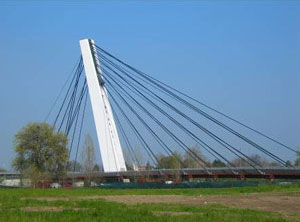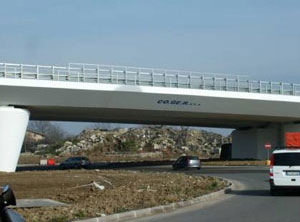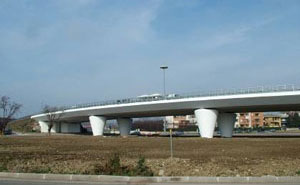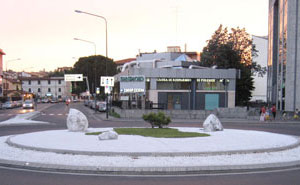Territories in Southern Italy and in the equatorial belt (intertropical zones), dry and low cloudiness areas, seas, oceans and in general all low albedo surfaces, are favourite locations to implement the proposed solution.
Interesting economical opportunities could arise for all the poor and developing countries in such areas.
If the global warming reduction effectiveness of reflecting surfaces was internationally acknowledged, these countries could join the Emission Trading system instituted by european directive 2003/87/CE. A certification procedure could be established under the “BIANCO RIFLETTENTE” project: the effectiveness of reflecting surfaces could be monitored in time using high definition satellite differential spectrophotometry; a coefficient of depreciation could be evaluated. Therefore, even small sized surfaces could economically benefit from this project.
As an example, a 2 m2 “Bianco Riflettente” horizontal surface placed in Quagadougou (Burkina Faso, site with a high level of sunshine), can compensate for the global warming produced by one ton of CO2 emitted in the atmosphere. Following the goal, decided during the recent G8 in Germany, of reducing the global warming to a maximum of 2 °C before 2050, the proposed reflecting surface in Burkina Faso should be kept in full efficiency for 40 years. This period is long enough to illustrate the example (it could be reduced to 20 or 30 years if international agreements allow).
In 2008 penalty for failing Kyoto’s goals will rise to 100 euros per ton
of CO2; today, after a period of market fluctuations, the cost
of the emission unit is rising and it will likely reach 80 Euro/ton in
the next future. Thus, every single squared meter of “Bianco Riflettente”
surface, albedo-certified, installed in Quagadougou could be worth, under
the emission trading system, a minimum of 1 euro for 40 years. Some countries
could see their annual family average income doubling or tripling by buildin
and maintaining for 40 years 1000 or 2000 m2 of “Bianco Riflettente”
surfaces. Every year the certification authority, through satellite measures,
would guarantee the effectiveness of accomplished maintenance on the reflecting
surfaces, evaluating the energy reflected and determining the annual amount
to be paid. In order to install reflecting surfaces, operations could
be achieved by simple technologies like kits for painting large surfaces,
hand pumps to spray whitewash on the roofs, etc.
This example shows how to create new scenarios in the international relations between the North and the South of the world, allowing for income increase even in those poor countries where drought and desertification force the population to emigrate. Due to the easiness of technology involved, chances to increase income in poor countries have a double effect: a social and humanitarian value and a potential restraint to illegal immigration towards developed countries.
Finally, even in developed coutries, the use of white reflecting everyday items (tents, umbrellas, garments, etc.) could accomplish global warming reduction without additional costs. For example a white reflecting station wagon car, with an albedo-certified (reflection coeff. 0.9) surface of 9 m2, could compensate for 1-1.4 tons of CO2 introduced in the atmosphere, equivalent to the vehicle’s emission for 10000 km (for instance Golf SW CO2 emission is 137 g/km). A white reflecting umbrella with an albedo-certified (reflection coeff. 0.9) surface of 90 cm2, could compensate for about 100-150 kg of CO2 introduced in the atmosphere.
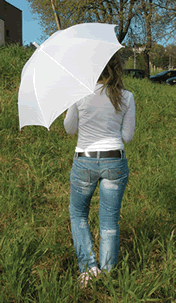
white reflecting personal item
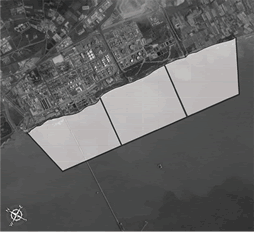
example of saltworks facilities at environmentally low-valued sites
medio nello spettro solare
Superfici acquose
Suolo
Neve
Biossido di titanio
Ossido di zinco
Alluminio Lucidato
Alluminio Ossidato
Rame Levigato
Rame Ossidato
Ferro Lucidato
Ferro Ossidato
Acciaio Lucidato
Acciaio Inossidabile
Smalto bianco
Intonaco a calce
Intonaco cementizio
Carbonato di magnesio
Sabbia asciutta
Country |
CO2 emission in 1990 Mt |
Kyoto’s reduction commitment (%) |
Requested white reflecting surface to fulfill Kyoto’s goal (km2) |
White reflecting surface necessary to compensate for all CO2 emission
(km2) |
| Austria | 59,20 |
8 |
113,66 |
1.420,80 |
| Belgio |
113,40 |
8 |
217,74 |
2.721,72 |
| Bulgaria |
82,99 |
8 |
159,34 |
1.991,76 |
| Canada |
457,44 |
8 |
658,72 |
10.978,58 |
| Cina |
4.180,00 |
- |
- |
100.320,00 |
| Danimarca |
52,10 |
8 |
100,03 |
1.250,40 |
| Estonia |
37,79 |
8 |
72,57 |
907,13 |
| Federazione Russa |
2.388,72 |
0 |
- |
57.329,28 |
| Finlandia |
53,90 |
8 |
103,49 |
1.293,60 |
| Francia |
366,53 |
8 |
703,75 |
8.796,86 |
| Germania |
1.012,44 |
8 |
1.943,89 |
24.298,63 |
| Giappone |
1.173,36 |
6 |
1.689,64 |
28.160,64 |
| Grecia |
82,10 |
8 |
157,63 |
1.970,40 |
| Irlanda |
30,71 |
8 |
58,98 |
737,26 |
| Lettonia |
22,97 |
8 |
44,11 |
551,42 |
| Liechtenstein |
0,20 |
8 |
0,40 |
4,99 |
| Lussemburgo |
11,34 |
8 |
21,78 |
272,23 |
| Monaco |
0,07 |
8 |
0,14 |
1,70 |
| Olanda |
167,60 |
8 |
321,79 |
4.022,40 |
| Polonia |
414,93 |
6 |
597,50 |
9.958,32 |
| Portogallo |
42,14 |
8 |
80,92 |
1.011,55 |
| Regno Unito |
584,07 |
8 |
1.121,43 |
14.017,87 |
| Repubblica Ceca |
169,51 |
8 |
325,47 |
4.068,34 |
| Romania |
171,10 |
8 |
328,52 |
4.106,47 |
| Slovacchia |
58,27 |
8 |
111,89 |
1.398,67 |
| Spagna |
260,65 |
8 |
500,46 |
6.255,70 |
| Stati Uniti |
4.957,02 |
- |
- |
118.968,53 |
| Svezia |
61,25 |
8 |
117,61 |
1.470,14 |
| Svizzera |
43,60 |
8 |
83,71 |
1.046,40 |
| Ungheria |
71,67 |
6 |
103,21 |
1.720,15
|
| Totale |
9.738,38 |
411.051,96 |
||
